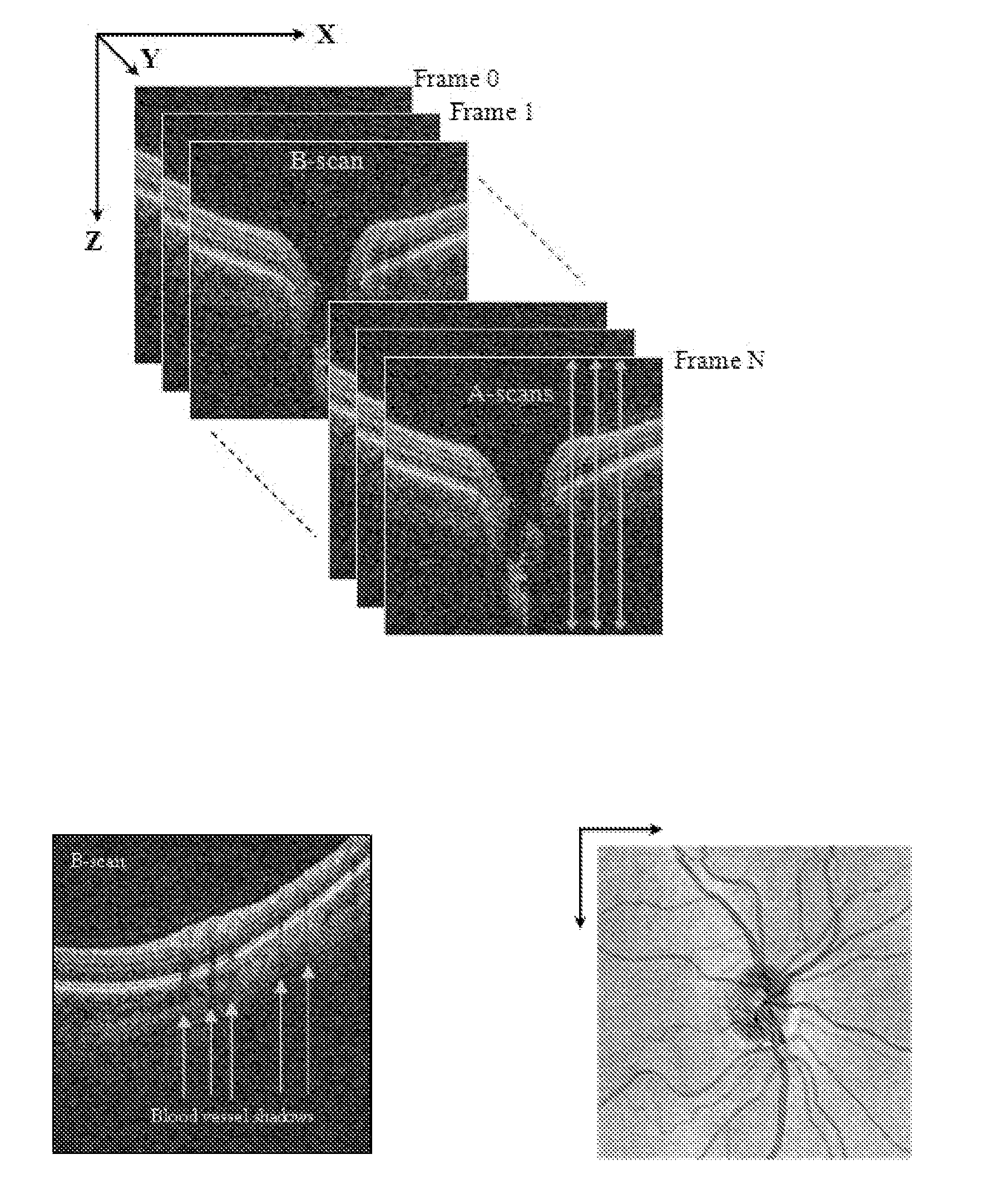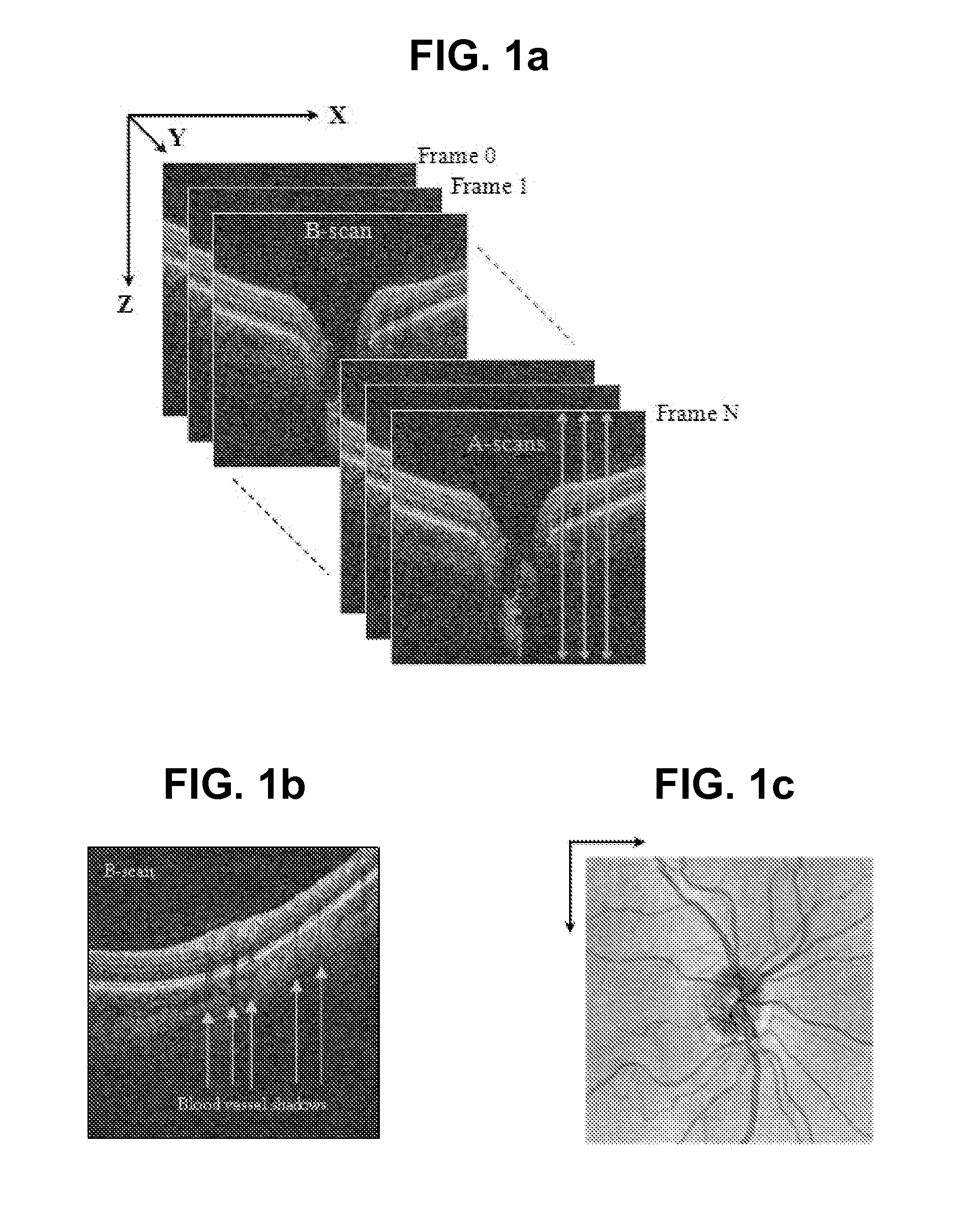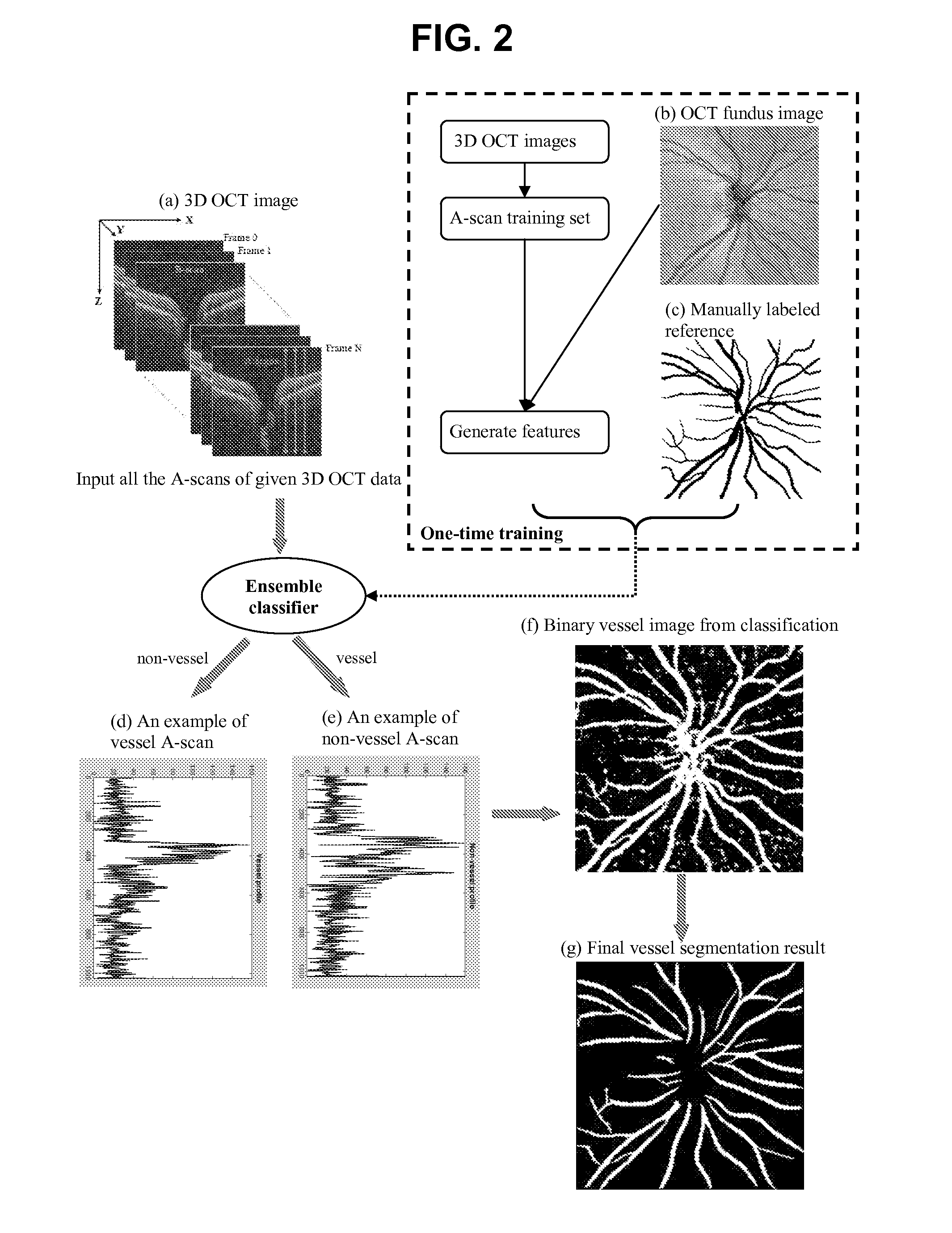Blood vessel segmentation with three dimensional spectral domain optical coherence tomography
a three-dimensional spectral domain, optical coherence tomography technology, applied in image enhancement, instruments, angiography, etc., can solve the problems of limited approach, reduced vessel pattern visibility, and difficulty in segmentation on oct imag
Active Publication Date: 2012-08-23
UNIVERSITY OF PITTSBURGH
View PDF9 Cites 63 Cited by
- Summary
- Abstract
- Description
- Claims
- Application Information
AI Technical Summary
Benefits of technology
[0008]It is an object of the present invention to provide a three-dimensional boosting learning algorithm trained to automatically identify and / or segment retinal blood vessels in a 3D OCT image without replying pre-segmentation. This allows the clinicians to obtain accurate pattern of the blood vessels for clinical analysis, for retinal image registration, and for early diagnosis and monitoring of the progression of glaucoma and other retinal diseases.
Problems solved by technology
When an OCT fundus image is generated (FIG. 1(c)) by averaging each A-scan, the visibility of vessel pattern may decrease due to the noise and high reflection on the top layers of the retina.
This makes vessel segmentation on OCT image a challenge, compared to a conventional 2D fundus image.
This approach is limited in that its performance highly depends on retinal layer segmentation.
Method used
the structure of the environmentally friendly knitted fabric provided by the present invention; figure 2 Flow chart of the yarn wrapping machine for environmentally friendly knitted fabrics and storage devices; image 3 Is the parameter map of the yarn covering machine
View moreImage
Smart Image Click on the blue labels to locate them in the text.
Smart ImageViewing Examples
Examples
Experimental program
Comparison scheme
Effect test
working examples
Non-Limiting Working Examples
[0055]The present invention is further illustrated by reference to the following description of methodology within the invention and corresponding results. See [12].
the structure of the environmentally friendly knitted fabric provided by the present invention; figure 2 Flow chart of the yarn wrapping machine for environmentally friendly knitted fabrics and storage devices; image 3 Is the parameter map of the yarn covering machine
Login to View More PUM
 Login to View More
Login to View More Abstract
In the context of the early detection and monitoring of eye diseases, such as glaucoma and diabetic retinopathy, the use of optical coherence tomography presents the difficulty, with respect to blood vessel segmentation, of weak visibility of vessel pattern in the OCT fundus image. To address this problem, a boosting learning approach uses three-dimensional (3D) information to effect automated segmentation of retinal blood vessels. The automated blood vessel segmentation technique described herein is based on 3D spectral domain OCT and provides accurate vessel pattern for clinical analysis, for retinal image registration, and for early diagnosis and monitoring of the progression of glaucoma and other retinal diseases. The technique employs a machine learning algorithm to identify blood vessel automatically in 3D OCT image, in a manner that does not rely on retinal layer segmentation.
Description
CROSS-REFERENCE TO RELATED PATENT APPLICATIONS[0001]This application claims priority from U.S. Provisional Application Ser. No. 61 / 182,495, filed May 29, 2009, which is incorporated herein by reference in its entirety.STATEMENT REGARDING FEDERALLY SPONSORED RESEARCH[0002]This invention was made with government support under RO1-EY013178-8, awarded by the National Institutes of Health. The United States government has certain rights in this invention.BACKGROUND OF THE INVENTION[0003]Spectral domain optical coherence tomography (SD-OCT) is a new high resolution imaging technique, capable of achieving micrometer resolution in depth. It allows detailed imaging of the eye structures. Three-dimensional (3D) OCT, which can yield 3D (cube) images of the retina, is a promising technique for automated analysis, early detection, and monitoring the progression of eye diseases, such as glaucoma, diabetic retinopathy and others.[0004]A blood vessel on a retinal image is not only an indicator of v...
Claims
the structure of the environmentally friendly knitted fabric provided by the present invention; figure 2 Flow chart of the yarn wrapping machine for environmentally friendly knitted fabrics and storage devices; image 3 Is the parameter map of the yarn covering machine
Login to View More Application Information
Patent Timeline
 Login to View More
Login to View More Patent Type & Authority Applications(United States)
IPC IPC(8): G06K9/62G06K9/00
CPCA61B5/0073G01B9/02083G01N21/4795G06K9/0061G06K9/4609G06K2009/00932G06T7/0081G06T7/0087G06T19/00G06T2207/10101G06T2207/30101G06T2210/41G01B9/02044G01B9/02091A61B5/02007A61B5/0066G06T7/11G06T7/143G06V40/193G06V40/14G06V10/443
Inventor XU, JUANTOLLIVER, DAVIDISHIKAWA, HIROSHIWOLLSTEIN, CHAIM GADSCHUMAN, JOEL S.
Owner UNIVERSITY OF PITTSBURGH
Features
- R&D
- Intellectual Property
- Life Sciences
- Materials
- Tech Scout
Why Patsnap Eureka
- Unparalleled Data Quality
- Higher Quality Content
- 60% Fewer Hallucinations
Social media
Patsnap Eureka Blog
Learn More Browse by: Latest US Patents, China's latest patents, Technical Efficacy Thesaurus, Application Domain, Technology Topic, Popular Technical Reports.
© 2025 PatSnap. All rights reserved.Legal|Privacy policy|Modern Slavery Act Transparency Statement|Sitemap|About US| Contact US: help@patsnap.com



